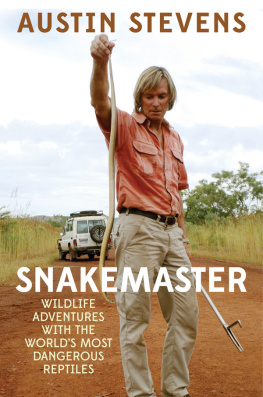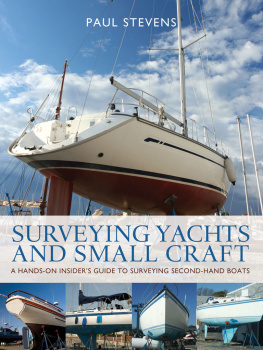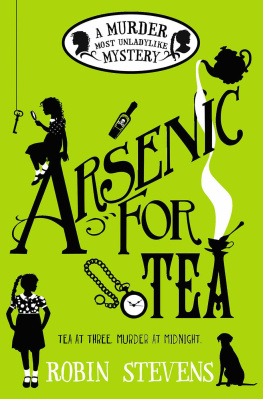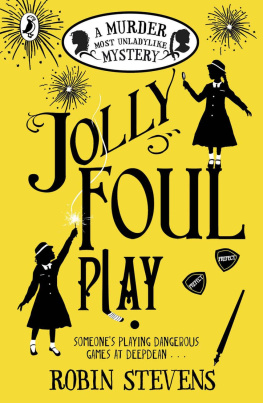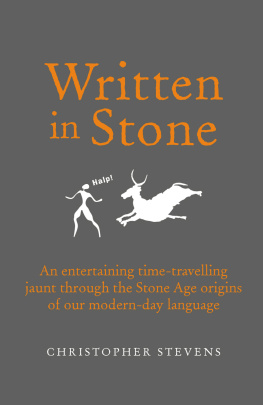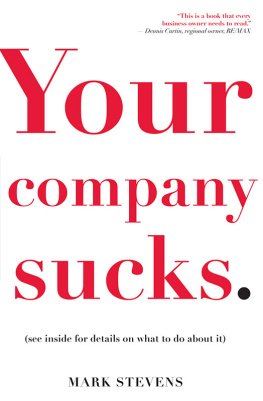Copyright 2014 by Austin Stevens
All rights reserved. No part of this book may be reproduced in any manner without the express written consent of the publisher, except in the case of brief excerpts in critical reviews or articles. All inquiries should be addressed to Skyhorse Publishing, 307 West 36th Street, 11th Floor, New York, NY 10018.
Skyhorse Publishing books may be purchased in bulk at special discounts for sales promotion, corporate gifts, fund-raising, or educational purposes. Special editions can also be created to specifications. For details, contact the Special Sales Department, Skyhorse Publishing, 307 West 36th Street, 11th Floor, New York, NY 10018 or .
Skyhorse and Skyhorse Publishing are registered trademarks of Skyhorse Publishing, Inc., a Delaware corporation.
Visit our website at www.skyhorsepublishing.com.
10 9 8 7 6 5 4 3 2 1
Library of Congress Cataloging-in-Publication Data
Stevens, Austin James, author.
Snakemaster : wildlife adventures with the worlds most dangerous reptiles / Austin Stevens.
pages cm
ISBN 978-1-62873-710-3 (hardback)
1. Stevens, Austin James. 2. Herpetologists--South Africa--Biography. 3. Poisonous snakes--Anecdotes. I. Title.
QL31.S748A3 2014
597.9092--dc23
[B]
2014002140
Cover design by Rich Rossiter
Ebook ISBN: 978-1-62914-053-7
Printed in the United States of America
For Amy
M EASUREMENT C ONVERSIONS :
1 kilometer = 1.609344 miles
1 meter = 3.28084 feet
1 kilogram = 2.20462 pounds
C ONTENTS
A UTHOR S N OTE
T his book discloses a part of my life story, lived somewhat randomly and wild, originating from a time before general and scientific information became available to everyone at the click of a mouse. This book is not intended to be an in-depth exploration into the many-faceted science that is herpetology today, but rather a trip across time, offering you, the reader, the opportunity to re-live with me a bygone era of adventures and experiences.
I NTRODUCTION
I t is generally accepted that one must make allowances for the inexperience of youth. One can of course only appreciate this when one is older, and try as you may to influence those younger or less experienced than yourself, inevitably they, too, must experience life as their youthful minds and enthusiasm dictate. (I, myself, am a typical example.) Thus, considering what knowledge one has gained overlets say forty or fifty years of lifeand knowing with some certainty that we cannot wholly transfer this knowledge to our children (or other youthful acquaintances) but that they must indeed experience life for themselves before attaining full gratification, however disastrous or otherwise the results might be, one might once more be compelled to contemplate the time honored question: What is life?
While the whole answer to this question is certainly not a simple one, it is certain that one cannot be what one is not, and one must forge along the path of life as best as possible and, with luck, live to be old and wise, for whatever it may be worth. Unfortunately, society as we know it today, amongst other factors, influences the path of life; sometimes even forcing it in one particular direction... good or bad. But here precisely is where what one is truly made of will surface, where the genetic makeup of the person will emerge in that form we simply consider as character. And though over the years ones surface character may mold, adapt, or even change, that which lies deep inside is forever.
I have always believed that no matter how one attempts to improve his- or herself, one can never be what one is not. The outside influences inflicted on a person by everyday life are to a large extent superficial and will serve only as an option. However, the genetic makeup of each individual is installed at the very beginning of life, never to be changed. This is, after all, what makes each one of us forever unique. However much one would like to emulate the enviable traits of another, one can never truly be what one is not!
Though I do not consider myself particularly endowed with an overabundance of enviable traits, there has always been one favorable aspect to my character, a factor that has served me well through the numerous traumatic events of my life. I am possessed by the most powerful will to live... forever, if it were possible. And not for one second have I ever considered the possibility of my own demise, not even in the face of sometimes overwhelming odds. This, I must stress, is not courage. This is simply how I am constructed.
When I was a young boy, I was convinced that physical pain should be endured as far as possible without artificial relief. My theory behind this being that, by so doing, the body and mind would be toughened, and therefore each time be better trained to cope. However, after experiencing a number of broken bones, sprains, and other schoolboy injuries, it became apparent to me that there were limits, though I still tried to maintain a tough standard. Later it was explained to me by a doctor that I had, in fact, the wrong end of the stick. By introducing artificial relief (painkillers), the body and mind are better able to tackle the healing process, without the added disruption incurred by the presence of pain.

Delirium is described as a disordered state of mind, with incoherent speech, hallucinations, and occasional mad ravings. At one point in my young life, I found myself to have all of this, and more. And though I was not at all in full comprehension of my state, my brain registered with some clarity that this was a time to endure... or die.
For the eight days that it took for the cytotoxic properties of the venom of a puff adder to fully distribute its devastating effects along the length of my arm, I surfaced consciously only between morphine doses, when the terrible pain forced me from the delirious blackness to the living hell of reality. Cytotoxins destroy tissue and blood cell walls, promoting hemorrhaging and necrosis, which if untreated will eventually lead to gangrene poisoning and death. To place ones arm into a fire, without the option of removing it, would roughly describe the painful effects of this tissue-destroying venom, while the resultant swelling, blistering, and exuding of plasmalike fluid from the bitten limb is frightening to witness. The serum created for snake bites is mostly unable to neutralize the cytotoxic properties of puff adder venom, though it is effective against other life-threatening agents.
In my painful state of delirium, I did of course have little comprehension of time and little recollection of actual happenings, other than those briefly taking place between six hourly morphine medications. Usually the burning pain would be returning to its full intensity long before the final hour, rendering me suddenly awake and crying for my arm to be removed from the fire. I remember once desperately searchingif not physically, then in my tormented mindfor my rifle, almost panic-stricken by its absence. I had been trained never to be without my rifle. Where was my rifle?! I must have screamed, for the next moment there was someone at my side, and a prick in my arm sent me back to a restless yet pain-free oblivion.
On another such occasion, as the pain once more seemed to be enveloping my whole being, my very fiber of existence, I was aware of people about me, probing me, examining me. A voice pierced my delirium, as though from the mouth of a megaphone, loud and concentrated in my head: Amputate the hand, or he will die.

